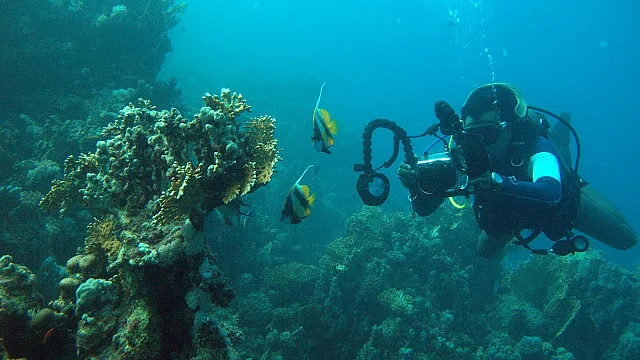If you had to, you’d probably describe ‘wreck diving’ as a means of diving into the past. Pushing past the dust underneath layers of dark, still waters and making unique Captain Haddock-ish discoveries.
The fact is ship wreck diving is in huge vogue right now. Be it the pristine waters around Australia or closer home, in the Andamans, seas around the world are teeming with wrecks of ships, cargo vessels, submarines and fighter planes – most of which sank or were shot down during World War II.
And divers are now heading to such sites to experience the thrill of watching history come alive in front of their eyes.
Wreck Diving is Catching on in India
“Wreck diving has indeed become very popular with Indian divers,” says Venkat Charloo of of Goa-based Barracuda Diving India.
Along with business partner Karen Gregory, he is among the highest qualified PADI (Professional Association of Diving Instructors) and SSI (Scuba Schools International) instructors in India and offers diving trips to different international locations under the Scubacentric banner.
“I had the privilege of diving to one of the most interesting wrecks in the world: the Thistlegorm in the Red Sea,” he recalls.
This is a 131-metre-long wreck of a British vessel that sank in 1941 when it was attacked from air. It was ferrying precious cargo of war supplies. At the time of the dive, Charloo had been taking a student through the SSI Advanced Adventurer course when, during the ascent, he dropped his camera – only to discover it missing when he reached the safety top.
“I went down again and managed to find it. Hence, it will remain a memorable wreck dive for me for more than one reason,” he grins.
World War II Wreck Sites are Popular Among Tourists
Just like the Thistlegorm, yet another iconic wreck dive site is the resting place of the USAT Liberty at Tulamben, Bali. This is one of those rare ships that saw action in both World War I and World War II, before being torpedoed by a Japanese submarine.
It was then beached near Tulamben. However, in the year 1963, the eruption of Mount Agung caused the vessel to slip off the beach and now it’s become one of the world’s most famous dive sites.
– Ranjana Deopa, Delhi-based entrepreneur
It was during her last diving vacation, in 2014, that she and her husband came across the Liberty. “Just hearing about its history was so amazing that I couldn’t wait for the dive! Usually this site is very crowded. However, we were lucky not to have too many fellow divers as it had been raining heavily in the morning,” she says.
She found the wreck transformed into an underwater haven of sorts with coral, anemones, schooling fish, barracudas, pygmy seahorse and groupers flitting about. The dive took her in and around the ship – which is 120 metres long and up to 35 metres in depth.
Each Sunken Ship, Airplane Tells a Story...
It is believed that you can still see the guns, toilets, anchor chain and other equipment intact at the ship wreck.
Yet another set of waters teeming with wrecks is around Palau, a picturesque archipelago in Oceania. “One of the most interesting wrecks there is of a Japanese airplane,” says Delhi-based Rakesh Gupta, who has dived in and around wrecks all over the world, including the famous Hardeep in Thailand. There is also the wreck of a small single-seat fighter, nearly southeast of the Koror island. What’s interesting is that both 20mm cannons are still attached to the wings and the propellor blades can be seen sticking out.
Here’s What you Should be Careful of
One must remember that a wreck transforms into an ecosystem of its own. “Fish start living in the crevices. It becomes an underwater city of sorts. Hence, move slowly. You never know when a big fish or a snake may emerge suddenly,” says Varun Mendiratta, a Mumbai-based marketing executive and a certified SSI diver. He recalls a dive in a wreck in the Andamans when an eel suddenly made an appearance and took the team by surprise.
Most importantly, when attempting a wreck dive, make sure you are properly trained and are accompanied by an experienced diver.
Not all wrecks can be explored. Some are located too deep. 99 per cent of the wrecks can only only be seen from the outside.
– Rakesh Gupta, wreck diver
There is also the danger of getting lost or trapped in wires, ropes or falling debris. “Use of special gas mixes like Trimix or Heliox may be necessary for wrecks which are very deep. Recreational scuba divers shouldn’t attempt very deep wreck dives,” says Charloo.
For even the most basic of wreck dives, it is crucial that a diver stays calm. A slight wrong movement and the entire structure could come crashing down.
Maintain your buoyancy. Maintain a constant state of breathing and all will be fine.
– Varun Mendiratta, certified SSI diver
(Avantika Bhuyan is a freelance journalist who loves to uncover the invisible India hiding in nooks and crannies across the country.)
(At The Quint, we question everything. Play an active role in shaping our journalism by becoming a member today.)
